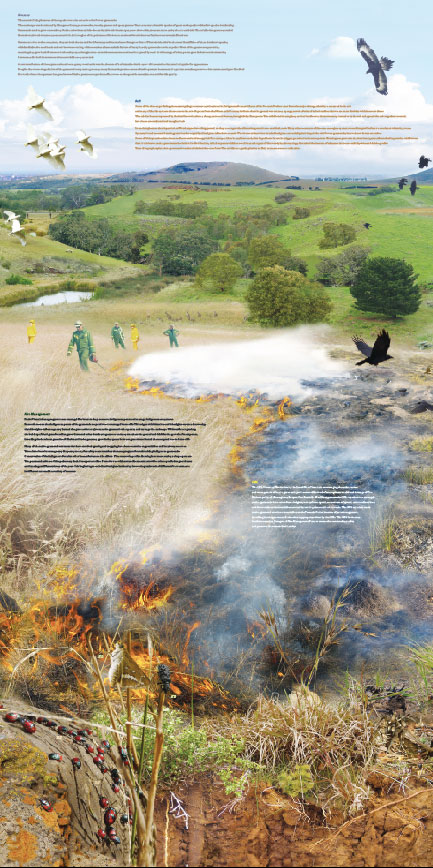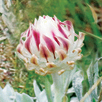
All images copyright© inherit earth

All images copyright© inherit earth
Grasses
The most defining features of these plains were the extensive wildflower grasslands. The landscape was dominated by Kangaroo Grass, poa tussocks, wallaby grasses and spear grasses. There are more than 160 species of grass on the plains with a few species dominating. Grasslands tend to grow on relatively fertile soils where rainfall is less that 700 millimetres per year - above this, trees are more easily able to establish. The rainfall has generally varied from about 500 millimetres a year around the drier region of the plains near Melbourne to about 800 millimetres further west towards Hamilton. Grasses are vital to the ecosystem; they are both shelter and food for many resident animals. Kangaroo Grass (Themeda triandra) is the most identifiable of these dominant species, with its distinctive seed heads and red-brown colouring - this colour is a characteristic feature of many healthy grasslands on these plains. Most of the grasses are perennial, meaning they grow back from root stock each year, although a smaller number are annuals and need to spread by seed. A wide range of other plants grow in between the tussocks, but usually die back in summer and are not visible all year round. A common feature of these grasslands and local grassy woodlands was the absence of a substantial shrub layer – this created a characteristic park-like appearance. Despite the overall degradation of the grassland ecosystems generally, many farmers kept small areas of native pasture because native pasture remains green well into summer and provides food for stock when other pasture has gone brown. Native pasture also produces finer wool on sheep and is sometimes valued for this quality.
Soil
Some of the challenges facing those attempting to conserve and restore the indigenous flora and fauna of the Volcanic Plains result from the major changes that have occurred in the soil and many of the bio-systems that relate to the soil. Reports from the Nineteenth Century indicate that the ground was actually spongy, not the flat hard-baked surface that we are more familiar with in recent times. The soil has been compressed by the hard hoofed animals, sheep, cattle and horses, brought in by Europeans. The soft footed marsupials, such as bandicoots, that constantly turned over the soil and spread the soil organisms around, have been exterminated and marginalised. Local dung beetles that depended on Wombat poo have disappeared, so they no longer take this underground to re-enrich the soil. Many other elements of the local ecological systems were disrupted before we ever knew what they were. Systematic and selected burning practices developed by Aboriginal tribes have ceased. We will never know how much Aboriginal stewardship had shaped the wildflower grasslands, but we know it was extensive. Some of their practices have been re-discovered and re-applied. For example it has been ‘discovered’ that ingredients in smoke trigger germination in some plants. Burning also prevents the dominant grasses from choking out the wildflowers that live in between the grass tussocks. Industrial fertilisation, suited to plants which evolved in another part of the world, has increasingly disturbed the balance of minerals that local orchids, lilies and daisies prefer. Tons of superphosphate have promoted weeds and choked the local flora. The orchids are getting harder to find, some are close to extinction.
Fire Management
Parks Victoria has a program to use managed fire burns to help conserve indigenous plants and manage indigenous ecosystems. Research tells us that indigenous plants of the grasslands respond well to managed burn-offs. This aligns with historical and Aboriginal cultural knowledge that Aboriginal tribes regularly burned the grasslands to rejuvenate the grass and other plants, and manage the landscape. Without fire or grazing, the build up of dead grass from Kangaroo Grass and other dominant grasses eventually smothers the ground and inhibits the growth of most plants, including the dominant grass itself. Herbs and bulbs generally grow in the spaces between grass tussocks and these respond well to burn-offs. Many of the native grassland remnants that have survived grazing and cropping have been located along roadsides and in railway reserves. These have been burnt regularly for years, mostly for safety reasons rather than as a program for maintaining indigenous grasslands. Conservation of the indigenous flora has often been a fortunate side effect. Fire conserving or fire farming is not necessarily a simple process. The plants and animals of the plains vary in their response to fire. Some do well with annual fire treatments while others prefer irregular burns or burning at different times of the year. It is beginning to look like Aboriginal husbandry involved a patchwork of different fire treatments in different seasons for a variety of reasons.
CFA
The CFA (Country Fire Authority) in South West Victoria is encouraging the maintenance and management of native grassland species as an effective defence against the risk and damage of fire. Under a policy of 'Ecologically Responsible Roadside Fire Management' the CFA says that well managed native grasslands have lower flame heights, slower flame speed, slower rate of spread, lower radiant heat and fewer embers than roadsides covered by exotic grasses and other weeds. The CFA says that much native grassland survives on roadsides on the Volcanic Plains because of past management, including burning to create firebreaks at appropriate times by the CFA. The CFA in the area has formulated an ‘Integrated Fire Management Plan’ to ensure the community’s safety and preserve the natural biodiversity.
